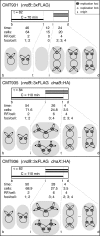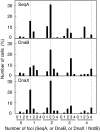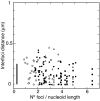Correlation between ribonucleoside-diphosphate reductase and three replication proteins in Escherichia coli
- PMID: 20102606
- PMCID: PMC2826317
- DOI: 10.1186/1471-2199-11-11
Correlation between ribonucleoside-diphosphate reductase and three replication proteins in Escherichia coli
Abstract
Background: There has long been evidence supporting the idea that RNR and the dNTP-synthesizing complex must be closely linked to the replication complex or replisome. We contributed to this body of evidence in proposing the hypothesis of the replication hyperstructure. A recently published work called this postulate into question, reporting that NrdB is evenly distributed throughout the cytoplasm. Consequently we were interested in the localization of RNR protein and its relationship with other replication proteins.
Results: We tagged NrdB protein with 3xFLAG epitope and detected its subcellular location by immunofluorescence microscopy. We found that this protein is located in nucleoid-associated clusters, that the number of foci correlates with the number of replication forks at any cell age, and that after the replication process ends the number of cells containing NrdB foci decreases.We show that the number of NrdB foci is very similar to the number of SeqA, DnaB, and DnaX foci, both in the whole culture and in different cell cycle periods. In addition, interfoci distances between NrdB and three replication proteins are similar to the distances between two replication protein foci.
Conclusions: NrdB is present in nucleoid-associated clusters during the replication period. These clusters disappear after replication ends. The number of these clusters is closely related to the number of replication forks and the number of three replication protein clusters in any cell cycle period. Therefore we conclude that NrdB protein, and most likely RNR protein, is closely linked to the replication proteins or replisome at the replication fork. These results clearly support the replication hyperstructure model.
Figures








Similar articles
-
Organization of ribonucleoside diphosphate reductase during multifork chromosome replication in Escherichia coli.Microbiology (Reading). 2011 Aug;157(Pt 8):2220-2225. doi: 10.1099/mic.0.049478-0. Epub 2011 Jun 9. Microbiology (Reading). 2011. PMID: 21659325
-
Replication fork and SeqA focus distributions in Escherichia coli suggest a replication hyperstructure dependent on nucleotide metabolism.Mol Microbiol. 2004 Jun;52(6):1597-612. doi: 10.1111/j.1365-2958.2004.04097.x. Mol Microbiol. 2004. PMID: 15186411
-
Pre-replication assembly of E. coli replisome components.Mol Microbiol. 2006 Nov;62(3):695-708. doi: 10.1111/j.1365-2958.2006.05417.x. Epub 2006 Sep 25. Mol Microbiol. 2006. PMID: 16999830
-
Protein--protein interactions in the eubacterial replisome.IUBMB Life. 2005 Jan;57(1):5-12. doi: 10.1080/15216540500058956. IUBMB Life. 2005. PMID: 16036556 Review.
-
Inactivation of Escherichia coli DnaA protein by DNA polymerase III and negative regulations for initiation of chromosomal replication.Biochimie. 1999 Aug-Sep;81(8-9):835-40. doi: 10.1016/s0300-9084(99)00213-8. Biochimie. 1999. PMID: 10572296 Review.
Cited by
-
Stochastic nucleoid segregation dynamics as a source of the phenotypic variability in E. coli.Biophys J. 2021 Nov 16;120(22):5107-5123. doi: 10.1016/j.bpj.2021.10.004. Epub 2021 Oct 8. Biophys J. 2021. PMID: 34627765 Free PMC article.
-
RecA-dependent replication in the nrdA101(Ts) mutant of Escherichia coli under restrictive conditions.J Bacteriol. 2011 Jun;193(11):2851-60. doi: 10.1128/JB.00109-11. Epub 2011 Mar 25. J Bacteriol. 2011. PMID: 21441507 Free PMC article.
-
An additional replication origin causes cell cycle specific DNA replication fork speed.Front Microbiol. 2025 Apr 30;16:1584664. doi: 10.3389/fmicb.2025.1584664. eCollection 2025. Front Microbiol. 2025. PMID: 40371120 Free PMC article.
-
Contribution of SPI-1 bistability to Salmonella enterica cooperative virulence: insights from single cell analysis.Sci Rep. 2018 Oct 5;8(1):14875. doi: 10.1038/s41598-018-33137-z. Sci Rep. 2018. PMID: 30291285 Free PMC article.
References
Publication types
MeSH terms
Substances
LinkOut - more resources
Full Text Sources
Molecular Biology Databases

